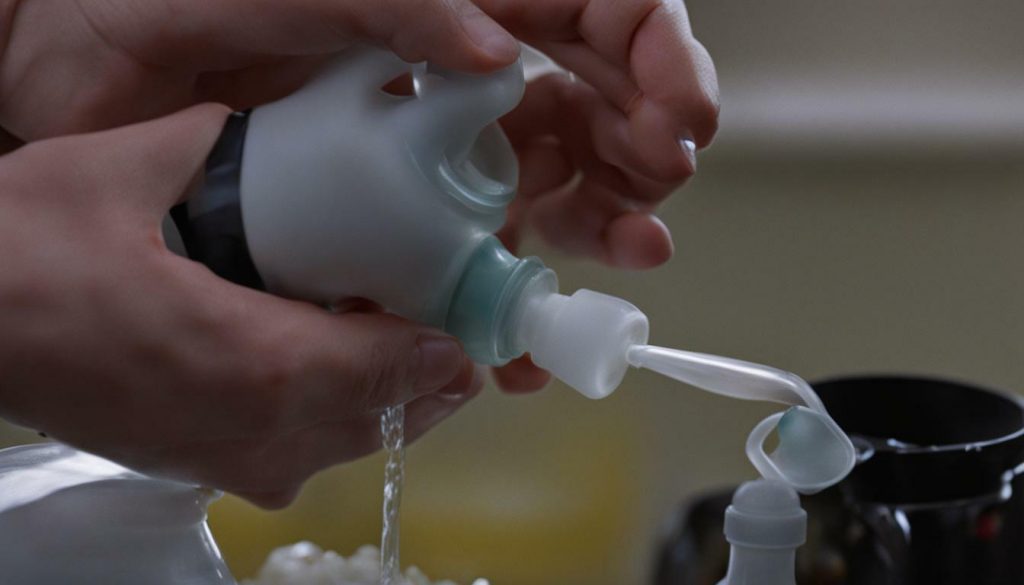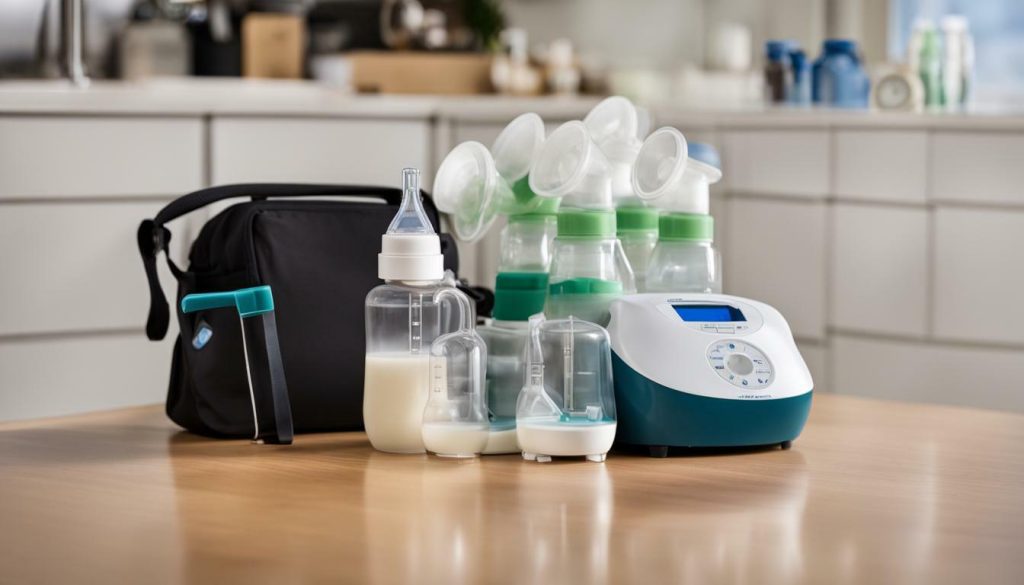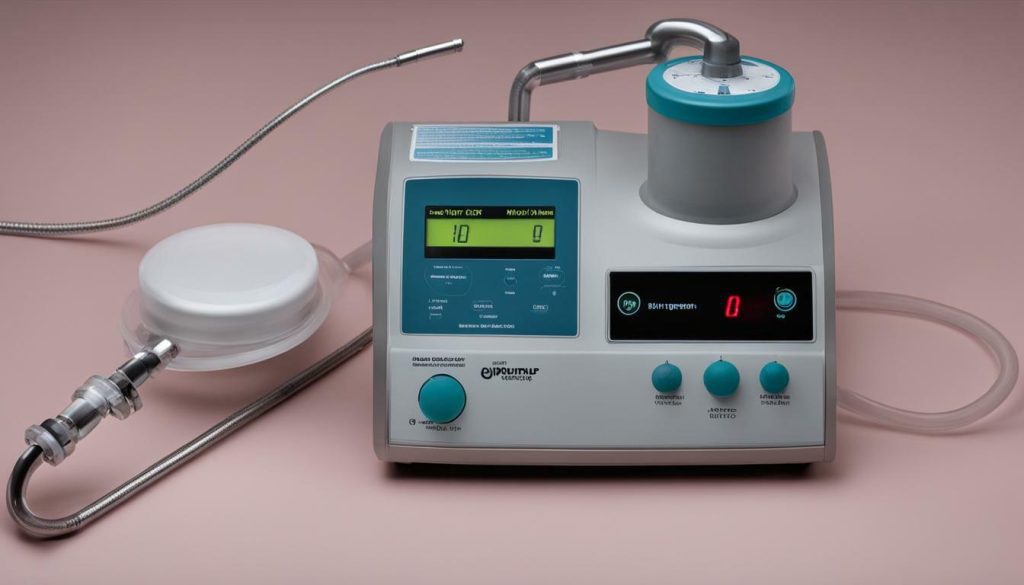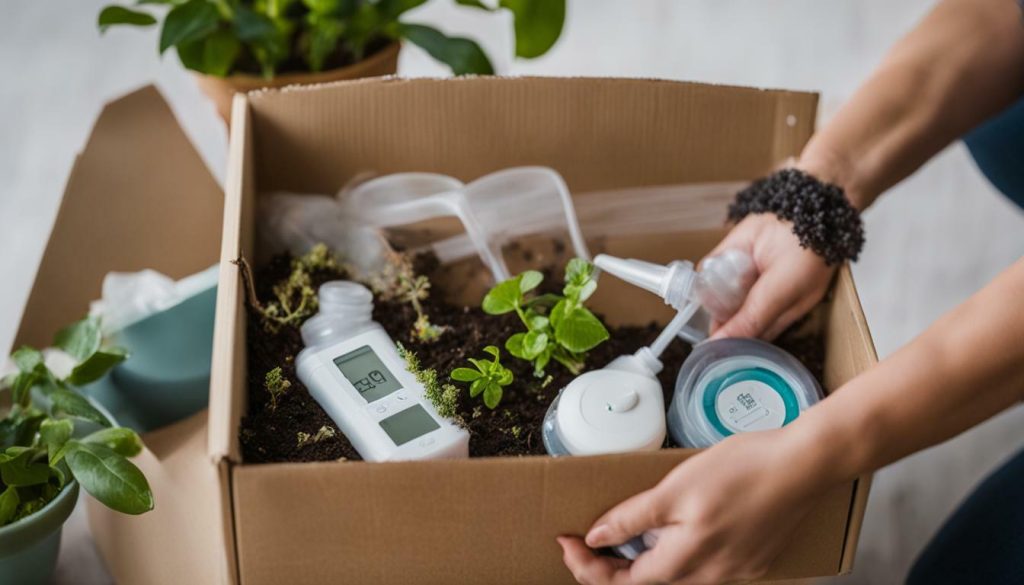
- Stop any supplements or nursing boosters that maintain milk supply.
- Begin by dropping evening pumping sessions.
- Decrease the length of pumping sessions by 25% and maintain this length for 4-5 days.
- Gradually increase the time between pumping sessions.
- Continue to decrease the frequency and length of pumping sessions until you have fully weaned.
Why Gradual Weaning is Important
Understanding why gradual weaning is crucial can help you make a smoother transition away from pumping. Gradually reducing pumping sessions and allowing your body to adjust to the decreased demand for milk production can help minimize discomfort and prevent potential complications.
During the weaning process, reducing pumping sessions gradually is essential to prevent issues such as engorgement, clogged ducts, and mastitis. By gradually decreasing the frequency of pumping, you give your body time to adapt and decrease milk production accordingly.
By taking gradual steps, like dropping evening pumping sessions first, you can maintain milk supply during the day while slowly reducing the overall demand for breast milk. This method allows your body to gradually adjust so that you and your baby can have a smooth transition away from pumping.

Remember that sudden stops can lead to painful engorgement, clogged ducts, and mastitis. It’s important to listen to your body throughout the weaning process and adjust your pumping routine accordingly. Shortening pumping sessions, increasing the time between sessions, and gradually eliminating pumping sessions can help you wean off pumping successfully.
Additionally, applying CaboCreme, a concentrated cabbage extract cream, can be beneficial during the weaning process. This cream helps decrease milk production and reduces the risk of engorgement. Using CaboCreme as recommended can provide additional support and alleviate discomfort.
Quoting an Expert:
“Gradual weaning is essential to avoid discomfort and minimize the risk of complications during the transition away from breast pumping. By reducing pumping sessions gradually and paying attention to your body’s signals, you can have a smooth weaning process.” – Dr. Jane Smith, Pediatrician
Stopping Supplements and Nursing Boosters
To begin the weaning process, it’s important to stop any supplements or nursing boosters that support milk supply. By discontinuing these, you signal to your body that the demand for milk production is decreasing. This step is crucial in ensuring a smooth transition off the breast pump.
Supplements and nursing boosters such as fenugreek, blessed thistle, or lactation teas are commonly used to maintain or increase milk supply. While they can be beneficial during the breastfeeding journey, stopping these supplements is necessary when weaning off pumping.
Consult with your healthcare provider or lactation consultant before making any changes to your supplement regimen. They can provide guidance on the best approach for gradually reducing or stopping the supplements while monitoring your milk supply and overall well-being.
| Supplement | Recommended Discontinuation Period |
|---|---|
| Fenugreek | Gradually decrease over 1-2 weeks |
| Blessed Thistle | Gradually decrease over 1-2 weeks |
| Lactation Teas | Replace with herbal tea or gradually decrease over 1-2 weeks |
Remember, every woman’s body responds differently, and it’s important to listen to your body throughout the weaning process.

“When discontinuing supplements and nursing boosters, it’s crucial to do so gradually. Abruptly stopping these can lead to a sudden drop in milk production, which may cause discomfort and affect your breastfeeding goals. Take your time and monitor your milk supply during the process.” – Dr. Emily Thompson, IBCLC
Dropping Evening Pumping Sessions
Start by eliminating the evening pumping sessions as you begin your journey towards weaning off pumping. This step allows you to gradually reduce the frequency of pumping while still maintaining milk supply during the day. By doing so, your body will adjust to the decreased demand for milk production.
Remember, this process should be gradual to avoid discomfort and negative side effects. It is recommended to drop one pumping session at a time, allowing your body to adapt before moving on to the next step.

As you progress in your weaning journey, it is important to listen to your body and pay attention to any signs of discomfort. Sudden cessation can lead to painful engorgement, clogged ducts, and even mastitis. Take your time and make adjustments as needed to ensure a smooth and comfortable transition.
| Benefits | Explanation |
|---|---|
| Lower milk supply in the evening | Gradually reducing pumping sessions in the evening will signal your body to produce less milk during that time, making it easier to wean off pumping. |
| Improved sleep quality | Eliminating evening pumping sessions allows you to have more uninterrupted sleep, reducing fatigue and promoting overall well-being. |
| Increased time for self-care | With fewer pumping sessions, you will have more time available to prioritize self-care activities and spend quality time with your baby. |
Remember, every mother’s journey is unique, and there is no one-size-fits-all approach to weaning off pumping. These steps and tips are intended as a guide to help you navigate the process smoothly. Trust your instincts and do what feels right for you and your baby.
Decreasing Pumping Session Length
To continue the weaning process, gradually decrease the length of your pumping sessions. This step allows your body to adjust to the reduced demand for milk production and helps prevent discomfort and engorgement. Start by shortening each pumping session by 25% and maintain this new length for 4-5 days before making any further adjustments.
Here’s an example to help you understand:
| Day | Original Pumping Session Length | Reduced Pumping Session Length |
|---|---|---|
| Day 1-4 | 20 minutes | 15 minutes |
| Day 5-8 | 15 minutes | 11 minutes |
| Day 9-12 | 11 minutes | 8 minutes |
By gradually reducing the length of your pumping sessions, you are giving your body time to adjust and decrease milk production gradually. This approach helps minimize discomfort and reduces the risk of engorgement.
Remember to pay attention to any signs of discomfort or fullness in your breasts. If you experience any issues, consider adjusting the length of your pumping sessions at a slower pace or consult with a lactation consultant for additional guidance.

“When reducing the length of your pumping sessions, it’s important to find a pace that feels comfortable for you. Listen to your body and make adjustments accordingly. If you experience any discomfort or notice a decrease in milk supply, slow down the process and give yourself more time to adjust. Everyone’s weaning journey is unique, so it’s crucial to find a pace that works best for you.”
Increasing Time Between Pumping Sessions
As you progress in your weaning journey, it’s important to gradually increase the time between your pumping sessions. This allows your body to adjust to longer periods without pumping and reduces milk production accordingly. By extending the intervals between pumping sessions, you can continue to decrease the frequency of pumping and move closer to quitting breast pumping altogether.
One effective technique to increase time between pumping sessions is to add an extra 15 minutes between each session. For example, if you currently pump every three hours, you can extend it to three hours and 15 minutes. Over time, you can add even more time to slowly wean off pumping. Remember to listen to your body and adjust the time intervals based on comfort and milk supply.
During this period, it’s important to monitor any signs of engorgement or discomfort. If you experience any symptoms, you may need to adjust the intervals between sessions. Additionally, massaging your breasts and applying warmth or cold compresses can help alleviate discomfort and prevent any potential issues such as clogged ducts.

It’s worth noting that every individual’s weaning process is unique. What works for one person may not work for another. Trust your instincts and make adjustments according to your body’s needs. Remember to consult with a lactation consultant or healthcare professional for personalized guidance and support throughout your weaning journey.
Continuing to Decrease Frequency and Length of Pumping Sessions
Keep reducing the frequency and length of your pumping sessions until you have successfully transitioned away from pumping. This gradual approach allows your body to gradually decrease milk production without causing discomfort or other negative side effects. Remember, weaning off pumping is a personal process, so it may take time to find the right pace that works for you.
To further ease the weaning process, consider using a combination of shortening your pumping sessions and increasing the time between sessions. By shortening each session and gradually increasing the gap between them, you can continue to reduce milk production while minimizing discomfort.
| Decrease Frequency and Length | Increase Time Between Sessions |
|---|---|
| Reduce pumping sessions by one every few days | Slowly increase time between sessions by 15 minutes |
| Monitor your breasts for any signs of engorgement or discomfort | Pay attention to your body’s signals and adjust the time accordingly |
| Continue this pattern until you are no longer pumping | Gradually reach a point where you no longer need to pump |
Listening to your body throughout the weaning process is crucial. If you experience any discomfort or notice a decrease in milk supply, take it as a sign to slow down or adjust your weaning schedule. Sudden stops can lead to engorgement, clogged ducts, and mastitis, so it’s important to proceed at a pace that is comfortable for you.
For additional support during the weaning process, consider using CaboCreme, a concentrated cabbage extract cream. Applying CaboCreme as recommended can help decrease milk production and reduce the risk of engorgement. Remember to consult with your healthcare provider before introducing any new products into your routine.

Remember, weaning off pumping is a gradual process that requires patience and attentiveness to your body’s needs. By following these steps and listening to your body, you can successfully transition away from pumping and continue on your breastfeeding journey.
Listening to Your Body and Avoiding Sudden Stops
Taking care of your body and avoiding sudden stops is essential during the weaning process. Sudden cessation of breast pumping can lead to painful engorgement, clogged ducts, and even mastitis. Therefore, it’s important to pay attention to any signs of discomfort and make adjustments to your pumping routine accordingly.
One effective strategy is to gradually decrease the frequency and length of pumping sessions. By reducing both factors over time, you allow your body to adjust to the decreased demand for milk production. This gradual approach minimizes the risk of engorgement and other negative side effects.
In addition, shortening your pumping sessions and increasing the time between sessions can further ease the weaning process. This dual approach helps to gradually decrease milk production while minimizing discomfort. By spacing out pumping sessions and reducing their duration, you allow your body to gradually adjust to lower milk production levels.
Another helpful technique is the use of CaboCreme, a concentrated cabbage extract cream. Applying CaboCreme as recommended can decrease milk production and reduce the risk of engorgement during the weaning process. This cream provides additional support and can alleviate discomfort, enabling a smoother transition away from pumping.

| Key Strategies for Weaning off Pumping | Benefits |
|---|---|
| Gradually decrease frequency and length of pumping sessions | Minimizes discomfort and risk of engorgement |
| Shorten pumping sessions and increase time between sessions | Gradually decreases milk production and minimizes discomfort |
| Use CaboCreme, a concentrated cabbage extract cream | Reduces milk production and risk of engorgement |
Shortening Pumping Sessions and Increasing Time Between Sessions
Shortening pumping sessions and increasing the time between sessions can be an effective strategy during the weaning process. By gradually reducing the length of each pumping session and extending the intervals between pumping sessions, you allow your body to adjust to the decreased milk demand.
During this phase, it is essential to listen to your body’s cues. If you experience any discomfort or engorgement, consider shortening the pumping sessions even further or increasing the time between sessions to provide your body with more time to regulate milk production.
Remember, the key is to go at a pace that feels comfortable for you. The weaning process can vary from person to person, so it’s important to be flexible and make adjustments based on your individual needs. Gradually reducing the frequency of pumping and the amount of time spent pumping will help your body transition smoothly.

To better visualize this process, here’s a table summarizing the steps:
| Steps | Actions |
|---|---|
| Step 1 | Drop evening pumping sessions |
| Step 2 | Reduce the length of pumping sessions by 25% |
| Step 3 | Gradually increase the time between pumping sessions |
| Step 4 | Continue decreasing the frequency and length of pumping sessions |
By following these steps and listening to your body’s signals, you can successfully wean off pumping while minimizing discomfort and maintaining your baby’s nutritional needs.
Using CaboCreme to Decrease Milk Production
Consider using CaboCreme, a concentrated cabbage extract cream, to aid in decreasing milk production during the weaning process. This natural remedy has been found to be effective in reducing milk supply and alleviating discomfort, making it a popular choice among breastfeeding mothers. Applying CaboCreme as recommended can provide additional support and reduce the risk of engorgement.

Derived from cabbage, CaboCreme works by applying a small amount of the cream to the breasts after each pumping session. The active compounds in the cabbage extract help to inhibit milk production and reduce engorgement symptoms. By incorporating CaboCreme into your weaning routine, you can gradually decrease milk supply while minimizing discomfort.
It is important to note that CaboCreme is not suitable for individuals with cabbage allergies, as it may cause adverse reactions. Additionally, it is always recommended to consult with your healthcare provider before starting any new treatments or supplements.
| Benefits of CaboCreme | How to Use CaboCreme |
|---|---|
|
|
By incorporating CaboCreme into your weaning journey, you can experience a smoother transition and minimize the discomfort associated with decreasing milk supply. Remember to listen to your body, follow the gradual weaning steps, and consult with your healthcare provider for personalized advice and support.
Conclusion
Congratulations on taking the first steps towards weaning off pumping! With the help of these tips and strategies, you can make the process as seamless as possible. Weaning off the breast pump gradually is important to avoid discomfort and negative side effects. By following a step-by-step approach, you can safely reduce your pumping sessions and transition away from pumping.
To start the weaning process, it is advisable to stop any supplements or nursing boosters you may be taking to maintain milk supply. This will signal your body to adjust to the reduced demand for milk production.
Next, begin by dropping the evening pumping sessions. This allows you to gradually reduce the frequency of pumping while still maintaining milk supply during the day. After that, decrease the length of your remaining pumping sessions by 25% and maintain this shortened length for 4-5 days before making further adjustments.
As you progress, gradually increase the time between pumping sessions. This will help your body adjust to longer stretches without pumping and reduce milk production accordingly. Throughout the weaning process, continue to decrease the frequency and length of your pumping sessions until you have fully weaned off pumping.
It is crucial to listen to your body and avoid sudden stops, as it can lead to painful engorgement, clogged ducts, and mastitis. Pay attention to any signs of discomfort and adjust your pumping routine accordingly. To further ease the weaning process, consider shortening your pumping sessions and increasing the time between sessions simultaneously. Additionally, you can try using CaboCreme, a concentrated cabbage extract cream, to help decrease milk production and reduce the risk of engorgement during weaning.
Remember, weaning off pumping is a gradual and personalized process. By following these steps and strategies, you can successfully navigate the transition and minimize discomfort for both you and your baby.
FAQ
Why is gradual weaning off pumping important?
Gradual weaning off pumping is important to avoid discomfort and negative side effects such as engorgement, clogged ducts, and mastitis. By gradually reducing pumping sessions, your body can adjust to the decreased demand for milk production.
Should I stop taking supplements or nursing boosters before weaning off pumping?
Yes, it is advisable to discontinue any supplements or nursing boosters you may be taking to maintain milk supply before starting the weaning process. This step helps signal your body to adjust to the reduced demand for milk production.
How do I drop evening pumping sessions?
To drop evening pumping sessions, simply stop pumping during that time period. This allows you to gradually reduce the frequency of pumping while still maintaining milk supply during the day.
How do I decrease the length of pumping sessions?
Start by decreasing the length of your pumping sessions by 25%. Maintain this shortened length for 4-5 days before making further adjustments. This gradual reduction helps your body adjust to less milk production.
How do I increase the time between pumping sessions?
After adjusting the length of pumping sessions, gradually increase the time between each session. This allows your body to adjust to longer stretches without pumping and reduces milk production accordingly.
How do I continue decreasing the frequency and length of pumping sessions?
Throughout the weaning process, continue to decrease the frequency and length of your pumping sessions. Gradually reduce both factors until you have fully weaned off pumping.
Why is it important to listen to my body and avoid sudden stops?
It is crucial to listen to your body and avoid sudden stops when weaning off pumping. Sudden cessation can lead to painful engorgement, clogged ducts, and even mastitis. Pay attention to any signs of discomfort and adjust your pumping routine accordingly.
Should I shorten pumping sessions and increase the time between sessions simultaneously?
Yes, you can consider shortening your pumping sessions and increasing the time between sessions simultaneously. This gradual approach helps decrease milk production while minimizing discomfort during the weaning process.
How can CaboCreme help decrease milk production?
CaboCreme, a concentrated cabbage extract cream, can be used to decrease milk production and reduce the risk of engorgement during the weaning process. Applying this cream as recommended can provide additional support and alleviate discomfort.
How can I safely wean off pumping?
By following the steps outlined in this guide, you can safely wean off pumping. It is important to gradually reduce pumping sessions, listen to your body, and avoid sudden stops to minimize discomfort and negative side effects.




